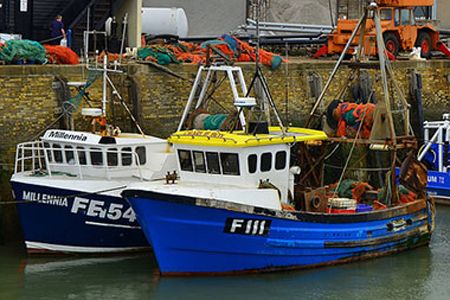Stirring Up Ocean Floor Can Boost Fish Populations

(ISNS) -- High-intensity raking of the seabed, called trawling, is a very effective fishing method that can inflict significant collateral damage on sea life. However, it can sometimes help fish populations to grow, scientists have found.
In a study appropriately titled "When does fishing lead to more fish?" Dutch scientists pinpointed the circumstances under which destructive trawling can actually stimulate fish numbers and lead to greater catches.
As industry professionals and activists seek sustainable solutions for dwindling fish populations and legislators in the European Union debate regulations that would ban deep-sea trawling, this research could inform the management of seafood production.
According to fishermen's lore, trawling can actually foster conditions that are better for fish. Michel Kaiser, a professor of marine conservation ecology at Bangor University in the U.K., calls this an ecological cultivation effect.
"It was fishermen's hypothesis-setting that stimulated this piece of science," said Kaiser, who wasn't part of the study but has investigated the effects of trawling for more than 20 years. "Trawling can remove competing species, and fishermen observed this in coastal locations with natural seabed disturbances."
Bottom trawling is conducted in areas like the North Sea and off the coast of Newfoundland, from shallow areas along the continental shelf to depths of more than 200 meters (about 650 feet). Twenty-three percent of the world's fish catch comes from bottom trawling, according to a U.N. Food and Agriculture Organization estimate. Trawling targets flatfish species like yellowtail flounder, sole, and plaice, which feed on bottom-dwelling worms.
Daniel van Denderen, a fisheries researcher at Wageningen University in the Netherlands and his colleagues found that to really understand the impacts of trawling, the indirect food web interactions between fish and their prey need to be better studied. Their paper was published in Proceedings of the Royal Society B: Biological Sciences.
Sign up for the Live Science daily newsletter now
Get the world’s most fascinating discoveries delivered straight to your inbox.
The new research put the fisherman's wisdom to the test by modeling the effects of trawling on the numbers of fish and their prey – larger seabed invertebrates like crabs or shrimp that may have hard shells, and soft-bodied worms and mollusks. The circumstances under which the trawling cultivation effect holds true and fish numbers increase depend crucially on these prey and their resilience to trawling. Larger non-fish species can be caught or crushed by the trawling process, while smaller ones may coast through the nets. The prey species that are more resistant to the effects of trawling – those that are soft-bodied, smaller, and able to reproduce more quickly – can proliferate, leading to more "fish food" and a jump in fish numbers. The mathematical model, which uses simplified ocean ecosystem dynamics to simulate prey and fish growth rates in response to various trawling intensities, explains how these factors can sometimes positively interact to boost fish yield.
"There may be a positive relationship between trawling and fish biomass," explained van Denderen, "but only at very limited trawling intensities." The sweet spot, where more frequent trawling leads to more fish, depends on the resistant prey species also being more energetically profitable for the fish – that is, preferable and tastier. This may not always be the case, said van Denderen; it depends on proximity to the coast, water depth, and the ocean floor ecosystem.
"How resistant and susceptible benthos [bottom-dwelling invertebrate prey species] interact and are eaten by fish is really important for understanding the impacts of trawling," he said. "The different responses of fish and benthos in our model could lead to more optimal management of systems being trawled."
In reality, van Denderen expects that a broader range of species, including ones not included in the model, may be sensitive to trawling, though some may be resilient and conversely benefit from trawling. Scientists need to develop a better understanding of the sea areas where this occurs, he said.
"We need to think about the impact of trawling on a case-by-case basis," said Kaiser. "This model can help us decide how best to harvest fish from a particular environment and ensure that we don't use inappropriate techniques that would reduce the potential production of food."
For example, certain fishing zones could benefit from trawling to cultivate prey species and maximize fish yield. On the other hand, "you can completely remove a habitat with trawling. We don't want to give the idea that you should find a sponge reef and turn it into a worm bed with trawling. The model is relevant to areas that are already modified by trawling," said Kaiser.
Inside Science News Service is supported by the American Institute of Physics. Amanda Alvarez has written about science for the Milwaukee Journal Sentinel, Yale Medicine, and GigaOM. She received her PhD in Vision Science from the University of California, Berkeley, and tweets at @sci3a.












